
Medicine Containers Page Menu: 1 2 3 4 5 6 7 <<First
Medicine Containers Used In the Golden Age of Piracy, Page 7
Container Closures - Leather
Leather was often used as a cover for gallipots and similar large-mouthed containers. Animal hide is only considered leather when it is tanned - that is cleaned and preserved so that it is stable. Leather has a high tensile strength, making it less likely to tear or puncture than other materials. Yet it is also formable and can be easily fit to the mouth of a container. It is resistant to mildew as well as heat and flame.1
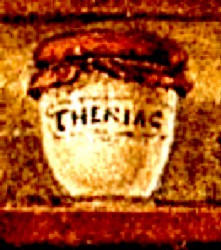
Leather Theriac Gallipot Cover,
From
The Wellcome Collection (1787)
Leather is often used in conjunction with other covers, probably because of its toughness. Maria Ketelby explained in her 1714 book A Collection of above Three Hundred Receipts in Cookery, Physick and Surgery that her 'very Rich Cherry-Cordial', "When you have thus filled your Pot [with the recipe], stop it with a Cork, and tie first a Bladder, then a Leather over it; and if you fear it is not close [sealed] enough, pitch it [apply pitch to make it airtight], down close, and bury it deep in the Earth six Months, or longer; then strain it out, and keep it close stopped for your Use."2 She was apparently not taking any chances of things getting into that pot. The cork would provide a solid platform, the bladder would be impermeable to liquids and the leather would protect them both when the pot was buried.
Sea and military medicine-chest book author William Fabry explained that "Unguents, and Fats are best kept in Galli-pots, or of Pewter, well tied down with Paper and Leather. And Turpentine so likewise."3 The use of paper as a cover in this case may have referred to parchment, possibly to provide a writing surface for labeling the container, although neither of these things are clear from his statement.
When discussing the closure of bottles of medicines that fermented, sea surgeon John Moyle said, "Let not such Bottles of Syrups be Corked, but covered well with Leather and tied hard, and the Cover pricked, and let your fermenting Electuaries be often stirred down."4 Here, the permeability of the leather would allow the fermenting to take place without building too much pressure inside the bottle and forcing out a more impervious closure or causing the bottle to explode.
1 "Leather Properties", http://www.muirhead.co.uk, gathered 9/19/15; 2 Maria Ketelby, A Collection of above Three Hundred Receipts in Cookery, Physick and Surgery, 1714. p. 121; 3 Guiliem. Fabritius Hildanus aka. William Fabry. Cista Militaris, Or, A Military Chest, Furnished Either for Sea or Land, 1674, p. 11; 4 John Moyle, Abstractum Chirurgæ Marinæ, p. 13-4
Container Closures - Parchment

Artist: Jost Amman
Preparing Animal Skins, From Eygentliche
Beschreibung
aller Stande auff Erden (1568)
Like leather, parchment is made from animal skins, particularly those of calves, sheep or goats. Unlike leather, it is not tanned, making it a suitable surface for writing. Parchment was the standard writing material for European scribes in the 4th - 15th centuries.1 It dates at least to Eumenes II, ruler of Pergamum from 197 to 159 B.C, being used because it could be written upon on both sides, if prepared properly.2
Parchment is prepared by first washing the skin in an alkali solution (or 'liming' it) to remove the grease and fats from the animal skin, stretching and scraping the skin, rubbing it with pumice to produce a smoother surface and finally whitening the material with chalk.
In a 1559 edition of Saladin of Ascolo's book Compendium Aroma tariorum, it stated that "apothecary jars should have straight necks and be closed by tying over the mouths with pieces of parchment, and sealing with pitch and wax."3 Parchment would be an ideal material for a top cover for medicine containers because it is strong and flexible as well as providing a surface where the medicine name could be written (and even erased). This may explain why gallipots "would be covered with parchment and secured with string to protect the contents."4 Historian J. K. Crellin points out that "English jars for ointments, electuaries, and confections, etc. ... have everted [outward turned] necks for the tied-on parchment covers", a practice which continued to be popular into the mid-18th century.5
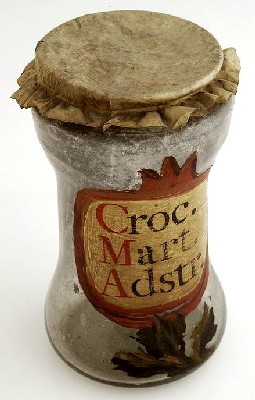
Parchment Cover For Crocus Martis (Iron Oxide)
From
The Wellcome Collection (c. 1700)
Parchment was definitely in use in medicine chests during this time. The Italian medicine
chest presented to Sir John Clerk of Penicuik
in 1698 by Cosimo III of Medici, Grand Duke of Tuscany contains a variety of "glass bottles sealed with corks, and the top of each bottle is covered with parchment."6
Several period apothecaries refer to 'paper' as a cover for medicines. This may refer to parchment, which was used as a writing surface at this time. In their translation of German physician Daniel Sennert's The Art of Chirurgery, Explained in Six Parts, Nicholas Culpeper and Abdiah Cole mention the use of "Paper or Parchment", suggesting the words may have been used interchangeably.7
Culpeper advises his readers, "Keep your Syrups either in Glasses or stone Pots, and stop them not with Cork nor Bladder, unless you would have the Glass break, and the Syrup lost ...only bind a paper about the mouth."8 Physician Thomas Fuller explains that Chalybeate Water should be kept "for Use in Bottles, not corked close, but ty’d over with a Paper only; for if it be kept close corked, or too long, it will corrupt, and stink, and be unfit for Use"9.
In both of these cases, the reason for using 'paper' is that it is a permeable material that will not keep the medicine from breathing, a function parchment would have served.
William Fabry also recommended using a 'paper' cover for unguents, fats and turpentine10, as mentioned in the previous section.
In his pharmacopoeia, Culpeper directs "stopping the glass close with wax and parchment" when bottling Aqua Celestis.11 He does not mention using paper as a container cover in that book, although its focus is oriented more towards the medicines than their storage.
1,2 Bamber Gascoigne, "History of Writing Materials", historyworld.net, gathered 9/19/15; 3 George Griffenhagen and Mary Bogard, History of Drug Containers and Their Labels, American Institute of the History of Pharmacy, Madison, WI, 1999, p. 6; 4 "Factsheet: Medical Objects in Social History Collections," www.shcg.org.uk, gathered 8/27/15, p. 8; 5 J.K. Crellin, Medical Ceramics, 1969, p. 10; 6 Helen Dingwall and Peter Worling, “‘A box of chymical medicines’: an Italian medicine chest presented to Sir John Clerk of Penicuik in 1698”, Journal of the Royal College of Physicians Edinburg, 2012: 42, p. 362; 7 Daniel Sennert, The Art of Chirurgery, Explained in Six Parts, Translated by Nicholas Culpeper and Abdiah Cole, 1661, p. 2718; 8 Nicholas Culpeper, The English Physitian Enlarged, 1666, p. 275-6; 9 Thomas Fuller, Pharmacopœia extemporanea, 1714, p. 499; 10 Guiliem. Fabritius Hildanus aka. William Fabry. Cista Militaris, Or, A Military Chest, Furnished Either for Sea or Land, 1674, p. 11; 11 Nicholas Culpeper, Pharmacopœia Londinesis, 1720, p. 98
Container Closures - Bladders
Bladders were used as medicine containers as has been discussed. The
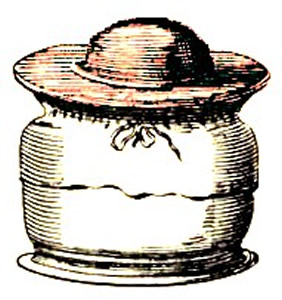
Bladder Covered Pot, From Medico-Physical Works, By
John Mayow (Modified From 1674 Original)
elastic impermeability of animal bladders also made them useful in sealing containers to help keep liquids from from getting in and out. English physician Nicholas Culpeper recommended that 'liquors' (meaning liquids), oils and balsams be "stopped with cork, or wax, and some bladder, that they may not be dissipated by the air."1 Bladders were often used in conjunction with other stoppers in bottles and pots. We have already seen how Maria Ketelby's cookbook combined a bladder with cork, leather, ties and even pitch to keep her rich cherry cordial sealed for aging during burial.2
When sealing distilled waters in glass containers, Culpeper says "your best way then is to stop them with a Bladder, being first wet in water, and bound over the top of the Glass."3 He noted that bladder use would prevent them from becoming musty. When discussing sea and military medicine chests, William Fabry likewise advised that syrups and distilled waters should be "close cork'd, and tied down with Bladders."4
Some of the dispensatories and pharmacopoeias mention using bladders to seal containers for particular medicines. English physician William Salmon said that when Extract of Colquintida was to be kept for a long period, the liquid must be evaporated out and the remainder kept "in a Jarglass or Galley-pot, tyed close over with a wet Bladder, for Use."5 Thomas Fuller advised that electuary of mistletoe be kept in a "Gally-pot, tied over very close with a Bladder."6
1 Nicholas Culpeper, The English Physitian Enlarged, 1666, p. 275-6; 2 Maria Ketelby, A Collection of above Three Hundred Receipts in Cookery, Physick and Surgery, 1714. p. 121; 3 Culpeper, p. 275; 4 Guiliem. Fabritius Hildanus aka. William Fabry. Cista Militaris, Or, A Military Chest, Furnished Either for Sea or Land, 1674, p. 10; 5 William Salmon, Pharmacopoeia Bateana, 1710, p. 274; 6 Thomas Fuller, Pharmacopœia extemporanea, 1714, p. 133
Container Closures - Sealants
Of the various bottle and jar closure devices we

Photo: Wiki User Meanos - Pine Resin
have seen, only a ground glass stopple fitted to each particular container seemed to have provided a truly good seal. Corks and pewter caps were imperfect, wax stopples would deform when warmed and leather, parchment and bladders all required tying down which could leave gaps in the folds of the material. Because of this, a variety of sealing materials have been applied to these other container closures throughout history. For example, in Horace's 'Ode VIII To Mæcenas', written about 25 B.C., Horace explains that Mæcenas "shall remove the cork fastened with pitch from that jar" of wine.1
Many of the sealants used during the golden age of piracy are only mentioned once, suggesting they may not have had widespread use. French physician mentions employing oil for this purpose (probably referring to olive oil): "Liquid juices are reposed in bottles, or other vessels with strait [tight] orifices whereupon Oil must be diffused, lest they be altered by the air."2 Like the Romans, Maria Ketelby's 1714 recipe for for rich cherry cordial suggests using pitch.3 And, in his 1717 cookbook, T. Williams explains that when tree sap is collected for making birch wine, "the bottles in which it drops must be corked close, and rosined [resined] or waxed."4(Note that the words pitch and resin were sometimes interchangeably at this time.)
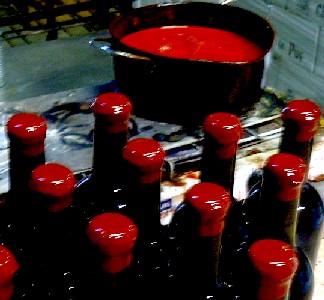
Photo: Flickr User DavityDave - Wax and Waxed Bottles
In addition to resin, Williams' quote contains the most often used sealant from this period, at least according to the frequency with which it appears in golden age of piracy texts: wax. Although wax has already been noted as a closure unto itself, it was used with other closures such as parchment or cork to provide a more air-tight seal. Saladin of Ascolo's 1559 edition of Compendium Aroma tariorum mentions sealing parchment with wax.5
English physician Nicholas Culpeper advises "stopping the glass close with wax and parchment" when making Aqua Celestis.6 Physician William Salmon suggests that when sealing a bottle of spirit of lavender flowers, the apothecary should "stop the Mouth with Cork, and a little Wax melted"7. He also says that salt of hartshorn should be kept "a Glass close stopt with Cork waxed over"8.
Wax would still seem to suffer from the same problems mentioned in the discussion of the use of wax as a closure: hot weather encountered during a ship's travels would cause it to soften and melt. Yet, it may still have been used. When explaining the containers used in military and sea campaigns, William Fabry recommended that "Chymical Oyls, as of Cinnamon, Cloves, Maces, Nutmegs, &c. ought to be preserv'd in double Glasses well stopt with Cork, and waxt."9
1 Horace, The Complete Works of Horace, Translated by A. Hinds, 1894, p.71; 2 Jean de Renou, A Medicinal Dispensatory, 1657, p. 146; 3 Maria Ketelby, A Collection of above Three Hundred Receipts in Cookery, Physick and Surgery, 1714. p. 121; 4 T. Williams, The Accomplished Housekeeper, and Universal Cook, 1717, p. 239; 5 George Griffenhagen and Mary Bogard, History of Drug Containers and Their Labels, American Institute of the History of Pharmacy, Madison, WI, 1999, p. 6; 6 Nicholas Culpeper, Pharmacopœia Londinesis, 1720, p. 98; 7 William Salmon, Pharmacopoeia Bateana, 1710, p. 97; 8 Salmon, p. 497; 9 Guiliem. Fabritius Hildanus aka. William Fabry. Cista Militaris, Or, A Military Chest, Furnished Either for Sea or Land, 1674, p. 10
Container Closures - Ties
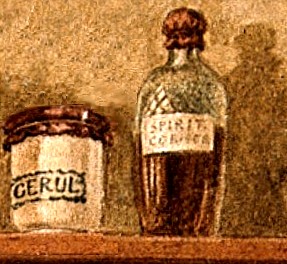
Tied Down Gallipot and Bottle Covers,
From
the Wellcome Collection (1787)
Several of the container covers mentioned required tying down to effectively close a container. These include leather, parchment and bladders, often tied over gallipots and similar large-mouthed containers. The design of a gallipot contains a protruding lip at the top for just such a purpose as can be seen in images in the discussion of gallipots.
Tying down the cover on such pots is referenced by a variety of medical authors. Physician William Salmon explains that Extract of Colquintida is to be kept "in a Jarglass or Galley-pot, tyed close over with a wet Bladder, for Use."1 Physician Thomas Fuller advised that Electuary of Mistletoe be decanted into "a Gally-pot, tied over very close with a Bladder."2 William Fabry noted "Unguents, and Fats are best kept in Galli-pots, or of Pewter, well tied down with Paper and Leather" when used in military and seagoing medicine chests.3
Pots weren't the only medical containers that required their covers to be tied down; corks put into bottles that were fermenting were also tied down to prevent the fermentation process from pushing the corks back out of the mouth of the bottle.
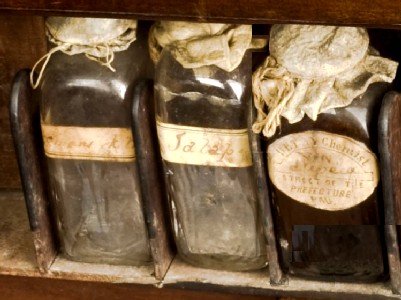
Tied Parchment or Waxed Cloth Medicine Bottle Covers in a Home Medicine Chest,
From the Wellcome Collection (19th century)
Containers that required closure in this fashion were designed with a lip around the top edge so that the ties wouldn't just slide back off the top of the bottle or jar.
Sir Kenelm Digby,
the eccentric owner of a glassworks and sometimes privateer introduced bottle-making technology that produced both a strong and much less expensive glass container... The dark green and brown containers had a so-called string rim on the neck so that a piece of twine could be tied over the cork to hold it in place. Corks were left sticking out of the bottle so they could be easily removed.4
Digby himself explained that when making cider, the brewer was to fill them and "stop them up and tye them, or else it will drive out the Corks.5
Physicians and surgeons tyed down the tops of bottles that weren't fermenting as well. Thomas Fuller explained that when making Chalybeate Water, the reader should "keep it for Use in Bottles, not corked close, but ty’d over with a Paper only"6. Tied down tops could also be a useful addition to a sea chest, which might shift around during travel. William Fabry said that syrups and distilled waters were "to be put into double [bottle] Glasses, close cork'd, and tied down with Bladders"7. Sea surgeon John Moyle agreed, warning his reader to "let not the Syrup Bottles that will ferment, be Corked, but only their Covers tyed hard down and pricked."8
1 William Salmon, Pharmacopoeia Bateana, 1710, p. 274; 2 Thomas Fuller, Pharmacopœia extemporanea, 1719, p. 133; 3 Guiliem. Fabritius Hildanus aka. William Fabry. Cista Militaris, Or, A Military Chest, Furnished Either for Sea or Land, 1674, p. 11; 4 George M. Taber, To Cork Or Not To Cork, 2009, p. 13; 5 Kenelm Digby, The Closet Of Sir Kenelm Digby Knight Opened, London: originally printed 1669, 1910, Anne MacDonell, ed., p. 36; 6 Thomas Fuller, Pharmacopœia extemporanea, 1714, p. 499; 7 Fabry, p. 11; 8 John Moyle, The Sea Chirurgeon, 1693, p. 42
The Sea Surgeon's Medicine Containers
So what would a golden age of piracy sea surgeon have used for containers? We have no extant examples of period medicine chests for sea-travel from this time to examine, so the evidence must be from the books written at the time. Based on the information contained in this article, I suggest the following containers would have been used.
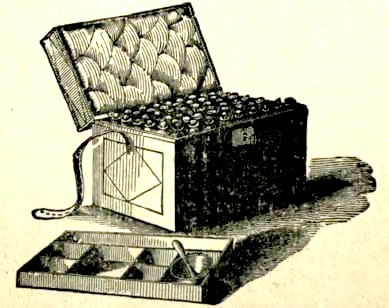
A 19th Century Medicine Chest and Salvatory or Plaster Box
Evidence suggests that the majority, if not all, of the liquids in his medicine chest would have been held in double-glass, square-bottomed bottles of varying sizes, ranging from an ounce (for medicines that were expensive or not used often) to about two or four pints. These bottles probably would be made of better quality green glass, although flint glass could have been used. However, with the greater expense incurred by flint glass and the impermanent nature of sea-going medicine bottles, green glass seems a more likely candidate. Such bottles would have had a lip on top to allow covers to be tied onto them. Most would probably have been corked with straight corks (the only type that existed at the time) and then covered with a parchment or leather cover tied down with twine. For distilled waters, they would have been covered only with a tied down bladder, pricked to allow gasses to escape from fermentation. Paper labels would probably be glued to the bottles so that the name of the medicine could be written on them.
Caustics and lozenges may have been stored in a burras pipe, pewter boxes or glass, although there is not much evidence in the sea surgeon manuals for pewter.
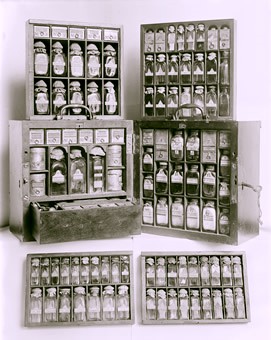
Stuart Threipland's Travelling Medicine Chest
From the Wellcome Collection (mid 18th century)
If glass were used for caustics, it would need a cover that would not be damaged by the contents, probably of wax. The burras tube would have fitted metal ends which would be simpler for the surgeon than wax stopples required for glass containers.
Ointments and unguents would have likely been stored in tin-glazed ceramic gallipots with a lip at the top for fastening the covers. These may have been covered with leather, parchment or bladders which were tied down with with twine. Corks might also have been fitted to these jars, although evidence for this is limited. If corks were used, they would probably still have a flexible cover of one of the types mentioned, tied down. If a parchment cover was used, the name of the medicine could be written upon it. Otherwise a paper label would likely be glued to the jar. A salvatory of six to eight compartments would contain the most-used unguents and ointments in such pots.
Dry medicine such as pills, roots, seeds, dried herbs and the like would be individually packed in folded brown papers on which the name of the contents would be written. The bags of medicines of the same type would then be placed together in cloth or leather bags to protect the paper containers. The name of the medicine class would be written on each bag. These bags would then be stored in the bottom or middle section of the medicine chest or in the surgeon's instrument chest.
Keep in mind that the evidence for medicine containers on a ship is limited primarily to the books by John Moyle and William Fabry with some supporting evidence from John Woodall. Fabry and Moyle were focused primarily on naval chests. Pirates typically stole their medicine chests from merchant ships who did not usually have rules about how the chest was to be composed, so any of the medicine containers described in this article could have been found on a period vessel.

